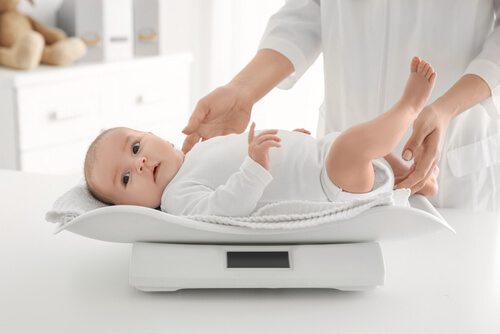Growth Hormone Deficiency in Children

Growth hormone deficiency or GHD is a relatively rare childhood condition.
It’s caused by a low production rate of this hormone in the pituitary gland, which is located at the base of the skull. It can also be caused by a brain injury, the presence of a tumor in this area of the brain, or exposure to radiation.
There are also other illnesses that can lead to growth hormone deficiency in children. This is not a hereditary condition.
In many cases, doctors aren’t able to determine the cause. In some children, it occurs from birth. Growth hormone deficiency may occur along with other congenital deformations, such as a cleft lip or palate.
An absence of growth hormones may also be connected to other endocrine disorders, such as a lack of gonadotropin, thyrotropin or vasopressin. These hormones regulate other important biological processes.
Frequent medical checkups are the best way to detect growth hormone deficiency at an early stage and take suitable action.
Parents and guardians should look out for the warning signs of this deficiency. An early diagnosis is essential for proper treatment.
Possible signs of growth hormone deficiency in children
The most obvious sign of a growth hormone deficit is short stature.
Children with GHD tend to be smaller than others in the same age group. Slow growth affects the shape of the face and limbs and leads to a stocky body type.
People with growth hormone deficiency generally have poor muscle tone, and the size of the penis may be small in males.
Low glucose levels in the bloodstream have the effect of delaying the onset of puberty.
Another thing to watch out for is the child’s self esteem. Feeling physically different from friends and classmates can make children feel extremely vulnerable.

Diagnosing growth hormone deficit
As part of regular medical checkups, your pediatrician will monitor your child’s growth against a growth chart. This kind of analysis can help to detect a growth hormone issue.
One of the first tests that doctors apply to confirm a diagnosis of growth hormone deficit is an x-ray. This can determine the patient’s bone age and how fast their bones are growing.
Another examination that the doctor is likely to carry out is a blood test to check their level of IGF, or insulin-like growth factor 1.
“In many cases, doctors aren’t able to determine the cause of growth hormone deficiency. In some children, it occurs from birth, although it isn’t hereditary”
One way to detect this condition is to provoke the body to produce growth hormones by administering drugs that stimulate the pituitary gland.
Your child’s specialist will then analyze their body’s response to hormone therapy.
Other analyses include tests to determine the body’s production of gonadotropin-releasing hormone (GnRH).
Clinical treatment of growth hormone deficiency
When growth disorders are caused by a hormonal deficiency, they can be treated with medicine. Specifically, a synthetic version of the hormone is administered via subcutaneous injection.
The medical specialist will determine the dosage, frequency and type of hormone therapy. In some cases, treatment will need to continue into adulthood.
Children with GHD tend to grow less than 2 inches a year. With proper treatment, however, they can grow up to 10 inches in the same period.
Although side-effects can occur, they’re generally light to moderate, while the effects of hormone therapy are dramatic.

Some of these side-effects include:
- Breast tissue growth in males
- Scoliosis
- Muscle and joint pain
- Inflammation of upper and lower limbs
- Headache
- Slight hypothyroidism
More severe side-effects are much rarer. These include headaches with aura symptoms, pancreatitis and problems with the hip bones.
The best way to get good results from growth hormone therapy is an early diagnosis.
When doctors catch and treat this condition early in life, children with growth hormone deficit are often able to reach a normal height by the time they’re adults.
Growth hormone deficiency or GHD is a relatively rare childhood condition.
It’s caused by a low production rate of this hormone in the pituitary gland, which is located at the base of the skull. It can also be caused by a brain injury, the presence of a tumor in this area of the brain, or exposure to radiation.
There are also other illnesses that can lead to growth hormone deficiency in children. This is not a hereditary condition.
In many cases, doctors aren’t able to determine the cause. In some children, it occurs from birth. Growth hormone deficiency may occur along with other congenital deformations, such as a cleft lip or palate.
An absence of growth hormones may also be connected to other endocrine disorders, such as a lack of gonadotropin, thyrotropin or vasopressin. These hormones regulate other important biological processes.
Frequent medical checkups are the best way to detect growth hormone deficiency at an early stage and take suitable action.
Parents and guardians should look out for the warning signs of this deficiency. An early diagnosis is essential for proper treatment.
Possible signs of growth hormone deficiency in children
The most obvious sign of a growth hormone deficit is short stature.
Children with GHD tend to be smaller than others in the same age group. Slow growth affects the shape of the face and limbs and leads to a stocky body type.
People with growth hormone deficiency generally have poor muscle tone, and the size of the penis may be small in males.
Low glucose levels in the bloodstream have the effect of delaying the onset of puberty.
Another thing to watch out for is the child’s self esteem. Feeling physically different from friends and classmates can make children feel extremely vulnerable.

Diagnosing growth hormone deficit
As part of regular medical checkups, your pediatrician will monitor your child’s growth against a growth chart. This kind of analysis can help to detect a growth hormone issue.
One of the first tests that doctors apply to confirm a diagnosis of growth hormone deficit is an x-ray. This can determine the patient’s bone age and how fast their bones are growing.
Another examination that the doctor is likely to carry out is a blood test to check their level of IGF, or insulin-like growth factor 1.
“In many cases, doctors aren’t able to determine the cause of growth hormone deficiency. In some children, it occurs from birth, although it isn’t hereditary”
One way to detect this condition is to provoke the body to produce growth hormones by administering drugs that stimulate the pituitary gland.
Your child’s specialist will then analyze their body’s response to hormone therapy.
Other analyses include tests to determine the body’s production of gonadotropin-releasing hormone (GnRH).
Clinical treatment of growth hormone deficiency
When growth disorders are caused by a hormonal deficiency, they can be treated with medicine. Specifically, a synthetic version of the hormone is administered via subcutaneous injection.
The medical specialist will determine the dosage, frequency and type of hormone therapy. In some cases, treatment will need to continue into adulthood.
Children with GHD tend to grow less than 2 inches a year. With proper treatment, however, they can grow up to 10 inches in the same period.
Although side-effects can occur, they’re generally light to moderate, while the effects of hormone therapy are dramatic.

Some of these side-effects include:
- Breast tissue growth in males
- Scoliosis
- Muscle and joint pain
- Inflammation of upper and lower limbs
- Headache
- Slight hypothyroidism
More severe side-effects are much rarer. These include headaches with aura symptoms, pancreatitis and problems with the hip bones.
The best way to get good results from growth hormone therapy is an early diagnosis.
When doctors catch and treat this condition early in life, children with growth hormone deficit are often able to reach a normal height by the time they’re adults.
This text is provided for informational purposes only and does not replace consultation with a professional. If in doubt, consult your specialist.








